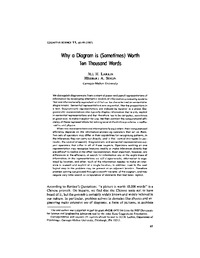Why a Diagram is (Sometimes) Worth Ten Thousand WordsJill H. Larkin, Herbert Simon
Erstpublikation in: Cognitive Science, Volume 11, Issue 1, January-March 1987, Pages 65-100
Publikationsdatum:
|
 |
 Diese Seite wurde seit 3 Jahren inhaltlich nicht mehr aktualisiert.
Unter Umständen ist sie nicht mehr aktuell.
Diese Seite wurde seit 3 Jahren inhaltlich nicht mehr aktualisiert.
Unter Umständen ist sie nicht mehr aktuell.
 Zusammenfassungen
Zusammenfassungen
We distinguish diagrammatic from sentential paper-and-pencil representations of information by developing alternative models of information-processing systems that are informationally equivalent and that can be characterized as sentential or diagrammatic. Sentential representations are sequential, like the propositions in a text. Diagrammatic representations are indexed by location in a plane. Diagrammatic representations also typically display information that is only implicit in sentential representations and that therefore has to be computed, sometimes at great cost, to make it explicit for use. We then contrast the computational efficiency of these representations for solving several illustrative problems in mathematics and physics. When two representations are informationally equivalent, their computational efficiency depends on the information-processing operators that act on them. Two sets of operators may differ in their capabilities for recognizing patterns, in the inferences they can carry out directly, and in their control strategies (in particular, the control of search). Diagrammatic and sentential representations support operators that differ in all of these respects. Operators working on one representation may recognize features readily or make inferences directly that are difficult to realize in the other representation. Most important, however, are differences in the efficiency of search for information and in the explicitness of information. In the representations we call diagrammatic, information is organized by location, and often much of the information needed to make an inference is present and explicit at a single location. In addition, cues to the next logical step in the problem may be present at an adjacent location. Therefore problem solving can proceed through a smooth traversal of the diagram, and may require very little search or computation of elements that had been implicit.
im Text Why a Diagram is (Sometimes) Worth Ten Thousand Words (1987)  Dieser Text erwähnt ...
Dieser Text erwähnt ...
 Aussagen KB IB clear | Ein Bild sagt mehr als 1000 Wortea picture says more than a thousand words |
 Begriffe KB IB clear |  Bilder
, Gedächtnismemory
, Langzeitgedächtnislong term memory Bilder
, Gedächtnismemory
, Langzeitgedächtnislong term memory
|
 Dieser Text erwähnt vermutlich nicht ...
Dieser Text erwähnt vermutlich nicht ... 
 Nicht erwähnte Begriffe | Kurzzeitgedächtnis, Ultra-Kurzzeitgedächtnis |
 Tagcloud
Tagcloud
 Zitationsgraph
Zitationsgraph
 Zitationsgraph (Beta-Test mit vis.js)
Zitationsgraph (Beta-Test mit vis.js)
 Zeitleiste
Zeitleiste
 11 Erwähnungen
11 Erwähnungen 
- Learning with media (Robert B. Kozma) (1991)


- Computer-Based Learning Environments and Problem Solving (Erik De Corte, Marcia C. Linn, Heinz Mandl, Lieven Verschaffel) (1992)
- Knowledge Visualization (Martin Jürg Eppler, Remo A. Burkhard) (2004)


- Tube Map Visualization - Evaluation of a Novel Knowledge Visualization Application for the Transfer of Knowledge in Long-Term Projects (Remo A. Burkhard, Michael Meier) (2005)

- Knowledge and Information Visualization - Searching for Synergies (Sigmar-Olaf Tergan, Tanja Keller) (2005)
- 1. Visualizing Knowledge and Information - An Introduction (Tanja Keller, Sigmar-Olaf Tergan)

- 12. Comprehensive Mapping of Knowledge and Information Resources - The Case of Webster (Sherman R. Alpert)


- 1. Visualizing Knowledge and Information - An Introduction (Tanja Keller, Sigmar-Olaf Tergan)
- The Risks of Visualization - A Classification of Disadvantages Associated with Graphic Representations of Information (Sabrina Bresciani, Martin Jürg Eppler) (2008)


- The Philosophy of Information (Luciano Floridi) (2011)

- Investigations of E-Learning Patterns - Context Factors, Problems and Solutions (Christian Kohls, Joachim Wedekind) (2011)
- Thinking with Diagrams - The Semiotic Basis of Human Cognition (Sybille Krämer, Christina Ljungberg) (2016)

- Digitales Lehren und Lernen (Jörg Zumbach) (2021)

 Volltext dieses Dokuments
Volltext dieses Dokuments
 |  Why a Diagram is (Sometimes) Worth Ten Thousand Words: Artikel als Volltext ( Why a Diagram is (Sometimes) Worth Ten Thousand Words: Artikel als Volltext ( : :  , 1198 kByte; , 1198 kByte;  : :  2021-03-21) 2021-03-21) |
 Anderswo suchen
Anderswo suchen 
 Beat und dieser Text
Beat und dieser Text
Beat hat Dieser Text während seiner Zeit am Institut für Medien und Schule (IMS) ins Biblionetz aufgenommen. Beat besitzt kein physisches, aber ein digitales Exemplar. Eine digitale Version ist auf dem Internet verfügbar (s.o.). Aufgrund der wenigen Einträge im Biblionetz scheint er es nicht wirklich gelesen zu haben.








 Biblionetz-History
Biblionetz-History